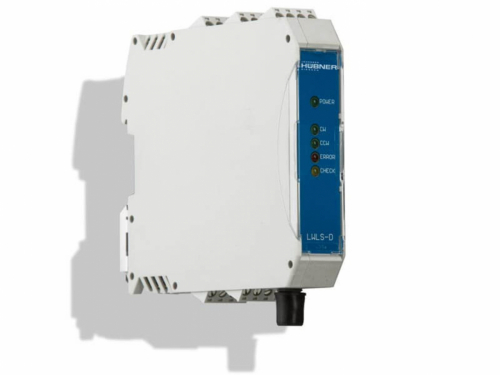FOC transmitter / decoder set - HTL/TTL (up to 100 kHz)
LWLS-T / LWLS-D(i)
Short info: Accessories electronical
- Module set (transmitter + decoder) for incremental signals (HTL or TTL)
- Alternative: Combination of decoder module and encoder with integrated transmitter
- Disturbance-free signal transmission up to 1000 m range; signal conversion time 2 µs
- Options: FOC break monitoring, galvanically isolated output blocks, aluminium die-cast housing for outdoor applications (IP66)
FOC transmitter / decoder set for incremental signals
FOC transmitters and FOC decoders are always installed when electric incremental signals are to be transmitted disturbance-free via fiber optic cables. They encode and transmit signals via a fiber optic cable to the decoder in the switchboard, where they can be used by the controller or other modules in the switchboard. In doing so they ensure high data transmission rates even over long cable lengths. Electrical isolation guarantees high levels of transmission reliability. It is possible to select HTL and/or TTL as input blocks. Optional FOC cable break monitoring is available to increase system reliability. Many Hübner Giessen encoder solutions are optionally also available with an integrated FOC transmitter.
| Attribute | Value |
|---|---|
| Product usage | Implement FOC transmission path (Incremental) |
| Supply voltage | 12-30 VDC |
| Signal input | Transmitter LWLS-T (switchboard) uad LWL-T (housing for outdoor applications) |
|
|
Signal input (from encoder): |
|
|
Incremental: 0°, 90°, N, STATUS; each with inverted signals |
|
|
Signal transmission (outputs transmitter module): |
|
|
Optical (to decoder): Fiber optic 62.5/125 µm or 50/125 µm with ST plug-in connector |
|
|
Signal level: |
|
|
HTL or TTL (RS 422A) |
| Signal output | Decoder LWLS-D and LWLS-Di (galvanically isolated output blocks) |
|
|
Signal output (to controller): |
|
|
Incremental: 0°, 90°, N, STATUS; each with inverted signals |
|
|
2 output blocks, optional additional galvanic isolation between the two output blocks (type LWLS-Di) |
|
|
Signal transmission (inputs decoder module): |
|
|
Optical (from transmitter): Fiber optic 62.5/125 µm or 50/125 µm with ST plug-in connector. All data via only one optical fibre. |
|
|
Signal level: |
|
|
HTL or TTL (2 output blocks, for each output block: HTL or TTL level) |
| Frequency range | 0 - 100 kHz |
| Casing: Transmitter | LWLS-T: Electronic housing for standard mounting rails |
|
|
Transmitter LWLS-T: Electronic housing for standard mounting rails LWL-T: Die cast metal aluminium housing for outdoor applications Decoder LWLS-D(i): Electronic housing for standard mounting rails |
| Casing: Decoder | LWLS-D(i): Electronic housing for standard mounting rails |
| Dimensions: Transmitter | LWLS-T: 23 x 120 x 115 mm / LWL-T: 125 x 80 x 57 mm |
| Dimensions: Decoder | LWLS-D(i): 23 x 120 x 115 mm |
| Device temperature range: Transmitter | LWLS-T: -20 °C to +70 °C / LWL-T: -25 °C to +85 °C |
| Device temperature range: Decoder | LWLS-D(i): -20 °C to +70 °C |
| Degree of protection: Transmitter | LWLS-T: IP20 (switchboard) / LWL-T: IP66 (outdoor area) |
| Degree of protection: Decoder | LWLS-D(i): IP20 (switchboard) |
| Electrical connection: Transmitter | LWLS-T: Connection terminals and FOC connector outside |
|
|
LWL-T: Terminal box (terminal strip and FOC connector inside) |
| Electrical connection: Decoder | LWLS-D(i): Connection terminals and FOC connector outside |
| Device options | Constant signal processing time < 2 µs (transmitter input to decoder output) |
|
|
Distances up to 1000 m |
|
|
Optional cable break and status monitoring |
|
|
2 output blocks, optional additional galvanic isolation between the two output blocks (type LWLS-Di) |
| Mechanical options | Aluminium die-cast housing for outdoor applications (Transmitter) |
Flohr Industrietechnik GmbH - Im Unteren Tal 1 - D-79761 Waldshut-Tiengen - Phone: +49 (0)7751 / 8731-0 - info@flohr-industrietechnik.de








